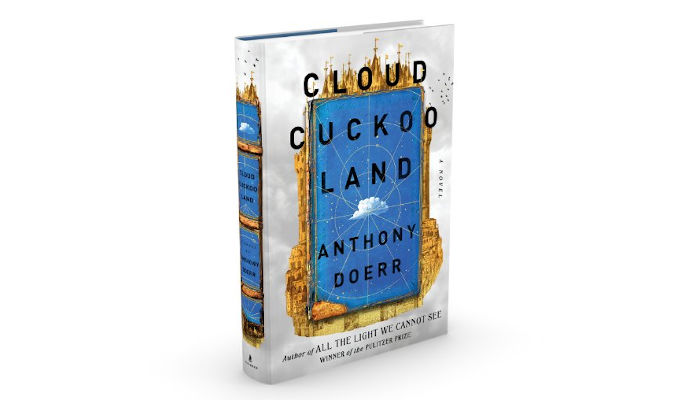In literary circles, admirers of great books often use words like “brilliant” and “extraordinary” when milder words would do. But when it comes to Idaho author Anthony Doerr, superlatives are sometimes inadequate, and exceptions must be made.
Like his newest novel due out this September, “Cloud Cuckoo Land,” there is nothing ordinary about Tony Doerr. With a knockout smile and a sunny energy on the streets of his hometown of Boise, he looks a typical local dad in outdoorsy clothes and a baseball cap. But beneath that Idaho Guy presentation is a man with a creativity so unique, his stories take us places no one but Doerr could have imagined.

When he was awarded the 2015 Pulitzer Prize for his second novel “All The Light We Cannot See,” Doerr was already several years into writing “Cloud Cuckoo Land,” which required extensive research.
Doerr describes “Cloud Cuckoo Land” as a perfect paradise in the sky, created by birds from all over the world. The name comes from Greek playwright Aristophanes’ 414 BC drama, “The Birds.” Taking his inspiration from the play, Doerr has opened each section of his book with a fictional ancient comic text by Greek philosopher Diogenes about a shepherd who travels to such a place.
The story begins in the near future, when a 14-year-old girl, Konstance, on the space vessel Argos finds and preserves the Diogenes manuscript with its story of Cloud Cuckoo Land. The story then takes a leap backward to 15th century Constantinople, when the ancient manuscript was first unearthed—and saved from destruction—also by a child. From there, the shepherd’s fable about building a perfect city in the sky travels through 900 years until we have seen the story’s influence on humankind. The smooth, swinging rhythm of Doerr’s writing takes the reader through the changes in eras and locales with ease and clarity.
“Cloud Cuckoo Land” features five main characters: Anna, enslaved in an embroidery house in 15th century Constantinople, rebels against conformity and wants to learn to read. Omeir is an oxherd in Bulgaria forced into the army; his and Anna’s stories will begin to intersect. Twenty-first century Lakeport, Idaho is the home of a boy named Seymour who tries to save a forest he loves from housing development construction. As more environmental threats emerge, he becomes a violent radical who runs up against 86-year-old Zeno, who is perpetually translating Diogenes’ fable of Cloud Cuckoo Land. And Konstance, traveling through space—while moving backwards in time—on the Argos, finds the story in a vast library from which she can’t escape and strives to understand the meaning of Cloud Cuckoo Land.
Each character suffers during their quest to save the story. Asked about this compelling theme, Doerr said, “Stewardship … telling about the trauma that each of these characters experience to save the silly story of the shepherd … what is it we want to preserve? In the beginning of writing the book, I wrote something about the O’Farrell cabin (a 19th-century home of impoverished Idahoans, which still stands in downtown Boise) and imagined a woman raising six kids in that tiny space … and what the preservationists have gone through to save it. Think of the people who have worked to preserve it because they feel it’s important. I wanted to dramatize that.”
When asked why different cultures have fables about moving to places, sometimes far away, to find something better, Doerr said, “For the great bulk of human history, people lived their whole lives and never understood the scope of our planet, or even of the continent they lived on. How big it was, how far it went, no one knew. Geography was indivisible from story, and for non-nomadic peoples, walls represented clear dividing lines. Inside was Us; outside was Them. So, of course, stories about what happened in places outside your city walls would take on immense, magnetic power.”
“Secondly, and similarly,” Doerr continued, “it’s important to remember that before the inventions of the zeppelin and the airplane, in places without mountains, birds could immediately gain views of the landscape that we humans could only reach through imagination. So, birds were often imbued with extra significance, because they could gain perspective over places, and move across distances, that we earthbound humans only could in dreams and fables. So, maybe that’s why we often told stories about people turning into birds, and traveling to magical, distant places.”
In his official biography Doerr said he had two goals for the novel: to embrace the full range of contemporary and historical meanings of the phrase “Cloud Cuckoo Land,” from “a beautiful utopia where there is no suffering, to an absurd and over-optimistic fantasy.” But just as important is the message of stewardship. “If I can tell a story about characters preserving things that are important,” said Doerr, “then maybe I can inspire readers to do the same.”
“Cloud Cuckoo Land” is an ambitious novel, one that transcends the boundaries of time and space to leave readers transformed and, more importantly, hopeful about our shared human experience. As one of the characters in the novel says, “Open this to learn what will amaze you.”


